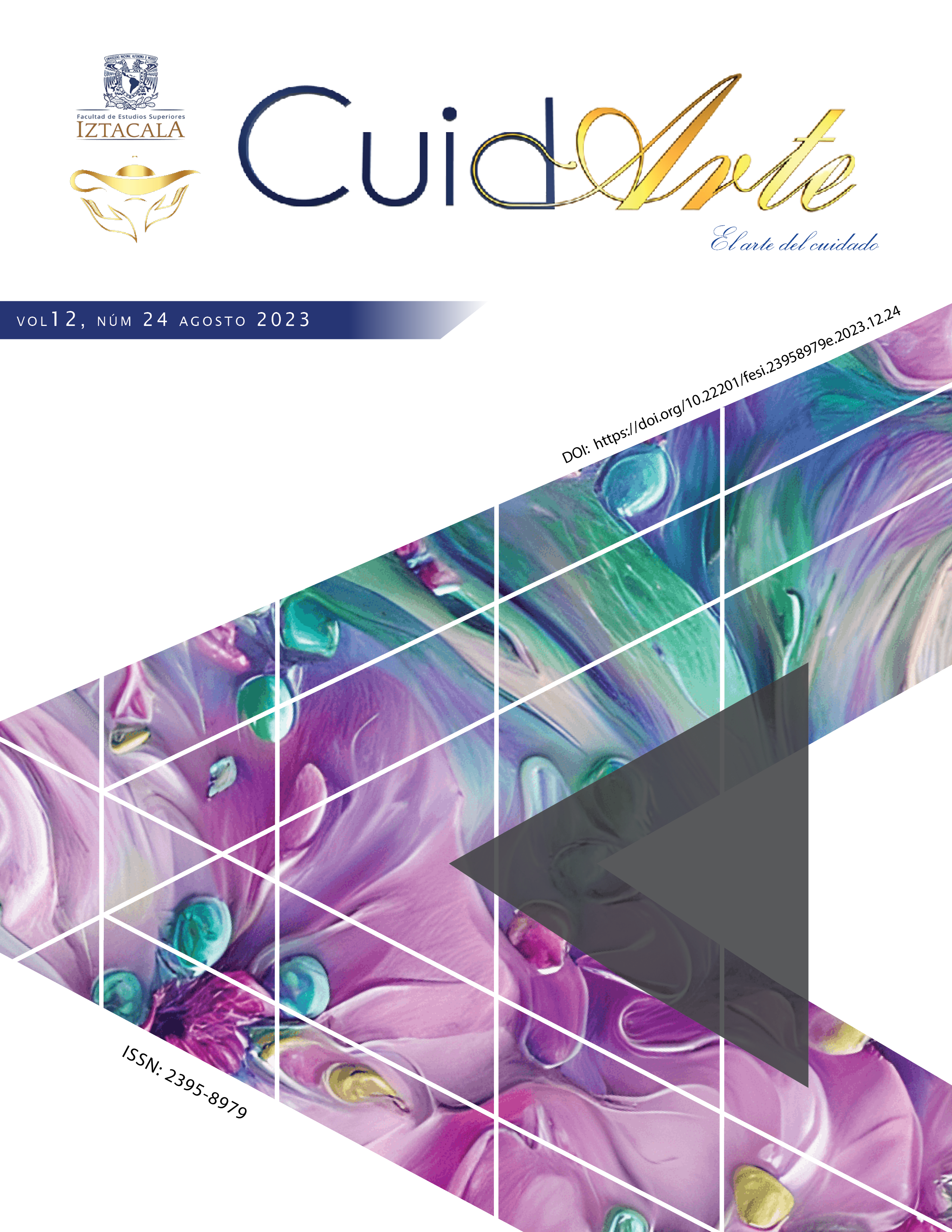Prevalence and intensity of symptoms during outpatient chemotherapy in patients of a tertiary care unit.
Main Article Content
Abstract
Introduction. Antineoplastic chemotherapy is one of the systemic cancer treatment modalities that is carried out through the administration of cytotoxic drugs, however, it causes symptoms during its administration. Objetive. To determine the prevalence and intensity of symptoms in patients who received outpatient chemotherapy treatment in a tertiary care unit. Methodology. Quantitative, cross-sectional, retrospective and analytical research. Carried out from March 1 to April 1, 2022 in the outpatient chemotherapy service of a tertiary care unit. Sample of 50 patients from 18 to 65 years of age without distinction of sex with a diagnosis of solid tumors. The instrument "Edmonton Symptom Assessment System (ESAS)" was used. Results. Exhaustion and difficulty sleeping are the main symptoms that occur during chemotherapy treatment, while the general feeling of malaise and shortness of breath occur as the least frequent. Regarding the intensity of the symptoms, exhaustion and difficulty sleeping are the symptoms that occur with greater intensity, compared to pain and shortness of breath, which are the symptoms with less intensity. By means of the complementary statistical analysis, differences in the intensity score of the symptoms between participants were determined. Conclusion. The prevalence and intensity of symptoms in patients undergoing chemotherapy treatment were identified.
Downloads
Article Details
Citas en Dimensions Service
References
Organización Mundial de la Salud. Día Mundial contra el Cáncer 2022: Por unos cuidados más justos. [Sitio en
Internet]. Disponible en: https://n9.cl/u4s8n
Ferlay J, Ervik M, Lam F, Colombet M, Mery L, Piñeros M, Znaor A, Soerjomataram I, Bray F. Global Cancer
Observatory: Cancer Today. Lyon: International Agency for Research on Cancer; 2020. Disponible en: https://gco.
iarc.fr/today.
Organización Panamericana de la Salud. Cáncer en las Américas. Oficina Regional para las Américas de la
Organización Mundial de la Salud. [Sitio en Internet].
INEGI. Estadísticas a propósito del día mundial contra el cáncer 2023. [Sitio de Internet]. Disponible en: https://n9.cl/
bw7d1
American Cancer Society. Cómo funcionan los medicamentos de quimioterapia 2019. [Sitio de Internet]. Disponible
Instituto Nacional del Cáncer. Definición de quimioterapia. [Sitio de Internet]. [Consultado 3 marzo 2023].
Disponible en: https://bit.ly/3ysiDU1
Mejía-Rojas ME, Contreras-Rengifo A, Hernández-Carrillo M. Quality of life in women treated with chemotherapy for
breast cancer in Cali, Colombia. Biomedica. 2020; 40(2):349-361. doi: 10.7705/biomedica.4971.
Arias-Rojas M, Carreno MS, Sepulveda GA, Romero BI. Sobrecarga y calidad de vida de cuidadores de personas con
cáncer en cuidados. Rev Cuid. 2021; 12(2): e1248. doi.org/10.15649/cuidarte.1248
Carrillo-González GM. Los grupos de síntomas en personas con cáncer: una revisión integrativa. Aquichan. 2017;
(3):257-269. doi.org/10.5294/aqui.2017.17.3.3.
Rha SY, Lee J. Symptom clusters during palliative chemotherapy and their influence on functioning and quality of
life. Support Care Cancer. 2017 ;25(5):1519-1527. doi: 10.1007/s00520-016-3545-z.
Beesley VL, Ross LT, King TM, Campbell R, Nagle MR, Obermair A, Grant P, DeFazio A, Webb MP, Friedlander LP.
Evaluating patient-reported symptoms and late adverse effects following completion of first-line chemotherapy for
ovarian cancer using the MOST (Measure of Ovarian Symptoms and Treatment concerns). Gynecol Oncol. 2022;
(2):437-445. doi: 10.1016/j.ygyno.2021.12.006.
Cabezon GL, Custodio CS, Khosravi SP. Prevalencia y etiopatogenia del dolor oncológico neuropático en el anciano.
Revista española de Geriatría y Gerontología. 2016 51(3) 159-163. doi. 10.1016/j.regg.2015.07.008
Howell D, Husain A, Seow H, Liu Y, Kustra R, Atzema C, et al. Symptom clusters in a population-based ambulatory
cancer cohort validated using bootstrap methods. Eur J Cancer 2012; 48 (16):3073-81. doi. 0.1016/j.ejca.2012.04.008.
Contreras-Mollinedo N, Alvarado-Aguilar S, Molina-Solis R. Insomnio en el paciente oncológico. Gaceta Mexicana de
Oncología. 2013; (12)2: 101-107. doi. https://n9.cl/iqtnl
Hernández M, Cruzado JA, Prado C, Rodríguez E, Hernández C, González MA, Martin JC. Salud mental y malestar
emocional en pacientes con cáncer. Psicosociología; 2012; (9)2-3: 233-257. Disponible en: https://n9.cl/smzqe
Medline plus. Alta después de una quimioterapia. Biblioteca Nacional de Medicina. 2022 [Sitio de Internet].
Disponible en: https://n9.cl/mgpmc
Ayala de Calvo LE, Sepulveda-Carrillo GJ. Necesidades de cuidado de pacientes con cáncer en tratamiento
ambulatorio. Enferm. glob. 2017; 16(45): 353-383. doi.org/10.6018/eglobal.16.1.231681.
Sosa-Rosasa MP, Luna-Victoria FM. El cuidado de Enfermería en el cuerpo de la persona con cáncer. Enferm. Univ.
; 11(2):73-78. Disponible en: https://n9.cl/gp7w6
Osorio-Castaño JH, Vallejo-Mesa HY, Adarve-Gutierrez SE, Iglesias-Moré S, Osorio-Vargas JA. Cuidado con calidad
en quimioterapia ambulatoria. Diseño y validación del nuevo instrumento Care Quality Ambulatory. Aquichan. 2023;
(2):e2324. Disponible en: https://acortar.link/OBO8Cm
Capela A, Alonso R, Araújo A, Craveiro-Lopes B, Fragoso RM, Mansinho H, Moutinho R, Teixeira JA, Vieira C,
Veiga D. A Dor Neuropática Periférica Induzida por Quimioterapia no Doente Oncológico/Sobrevivente de Cancro
[Chemotherapy-Induced Peripheral Neuropathic Pain in Cancer Patients/Survivors]. Acta Med Port. 2023; 36(2):77-80.
doi: 10.20344/amp.18750.
Tantoy IY, Cataldo JK, Aouizerat BE, Dhruva A, Miaskowski C. A Review of the Literature on Multiple Co-Occurring
Symptoms in Patients with Colorectal Cancer Who Received Chemotherapy Alone or Chemotherapy With Targeted
Therapies. Cancer Nurs. 2016; 39(6): 437–445. doi: 10.1097/NCC.0000000000000343.
Hernández-Sampieri R, Mendoza C. Metodología de la investigación. Las rutas cuantitativa, cualitativa y mixta,
Ciudad de México, México: Editorial Mc Graw Hill Education, p. 335

